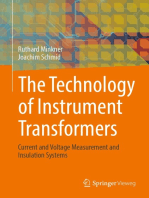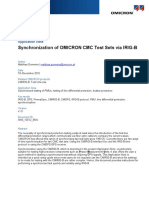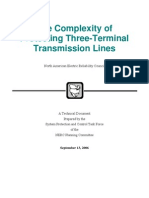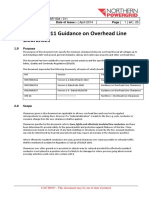Distance Protection Scheme
Distance Protection Scheme
Uploaded by
sajjad ramezanzadehCopyright:
Available Formats
Distance Protection Scheme
Distance Protection Scheme
Uploaded by
sajjad ramezanzadehCopyright
Available Formats
Share this document
Did you find this document useful?
Is this content inappropriate?
Copyright:
Available Formats
Distance Protection Scheme
Distance Protection Scheme
Uploaded by
sajjad ramezanzadehCopyright:
Available Formats
www.ijraset.
com Volume 4 Issue V, May 2016
IC Value: 13.98 ISSN: 2321-9653
International Journal for Research in Applied Science & Engineering
Technology (IJRASET)
Distance Protection Scheme for Transmission Lines
S.Tharun Kumar1, M.Karthikeyan2, M.Anand3, S.K.Surya4
1,3,4
Department of EEE, 2 Assistant Professor , Department of EEE
Velammal Engineering College, Chennai, Tamil Nadu
Abstract - This paper presents a protection scheme for transmission lines using the principle of distance relay. Even though
many schemes exist for the protection of transmission lines, distance protection scheme is optimal due to its appealing features
like directionality, reliability, selectivity etc. This paper evaluates the performance of distance relay in a specific zone for
different types of faults at different points along the line for various fault resistances. The relay is designed using
MATLAB/SIMULINK and the performance of the distance protection scheme is verified using the simulation results.
Index Terms- Distance protection, transmission line, MATLAB.
I. INTRODUCTION
Most high-voltage transmission systems are interconnected in a network system of circuit elements, usually of more than one
voltage sources. The interconnection of many lines presents a new set of conditions on the coordination of protective devices, since
the fault currents may flow to the fault point from both ends of any meshed line element. It was indeed necessary to protect the
transmission lines against faults. Initially, the overcurrent relays were used for the protection of transmission lines and then their
advanced level i.e.directonal overcurrent relays were used. Due to the complexity and some inadequacies of those relays, distance
relay [1] become common in exisistence in the protection of transmission lines, since it is immune to these problems. In Section I
the fundamentals of distance protection scheme is discussed. Section II provides the analysis and evaluation of the simulation of
distance relay. Section III provides the results of the simulation for different types of faults with various fault resistances. Section
IV provides the conclusion for this paper.
A. Working Principle of Distance Relay
The working principle of distance relay or impedance relay is best suited for the protection of transmission lines. There is one
voltage element from potential transformer and an current element fed from current transformer of the system. The deflecting torque
is produced by secondary current of CT and restoring torque is produced by voltage of potential transformer. In normal operating
condition, restoring torque is greater than deflecting torque. Hence the relay will not operate. But in faulty condition, the current
becomes quite large whereas the voltage becomes less. Consequently, deflecting torque becomes greater than restoring torque and
dynamic parts of the relay starts moving which ultimately close the No contact of relay. Hence clearly operation or working
principle of distance relay, depends upon the ratio of system voltage and current. As the ratio of voltage to current is nothing but
impedance a distance relay can be also called as impedance relay.
The operation of such relay depends upon the predetermined value of voltage to current ratio. This ratio is nothing but impedance.
The relay will only operate when this voltage to current ratio becomes less than its predetermined value. Hence, it can be said that
the relay will only operate when the impedance of the transmission line becomes less than predetermined impedance (voltage /
current). As the impedance of a transmission line is directly proportional to its length, it can be concluded that the distance relay can
only operate if fault is occurred within a predetermined distance or length of line.
The relay compare the secondary values of V and I, as to measure their ratio which is an impedance Zm,
Z f * C .T .ratio
Zm
V .T .ratio
Zm is the measured impedance called secondary impedance.
B. Zones of Protection
The simulated distance relay can be evaluated by a number of performance characteristics incorporated by the zones polarised mho
etc. In this paper the distance relay is evaluated using the mho characteristic with corresponding zones of protection [5] which is
©IJRASET: All Rights are Reserved 146
www.ijraset.com Volume 4 Issue V, May 2016
IC Value: 13.98 ISSN: 2321-9653
International Journal for Research in Applied Science & Engineering
Technology (IJRASET)
shown in the figure 1.
Fig. 1. Zones of protection
Numerical distance relays usually have a reach setting of up to 85% of the protected line impedance for instantaneous Zone 1
protection. The resulting 15% safety margin ensures that there is no risk of the Zone 1 protection over-reaching the protected line
due to errors in the current and voltage transformers, inaccuracies in line impedance data provided for setting purposes and errors of
relay setting and measurement of the distance protection must cover the remaining 15% of the line.
The reach setting of the Zone 2 protection should be at least 120% of the protected line impedance. In many applications it is
common practice to set the Zone 2 reach to be equal to the protected line section +50% of the shortest adjacent line. Zone 3 reach
should be set to at least 1.2 times the impedance presented to the relay for a fault at the remote end of the second line section. In this
paper the relay performance is evaluated in zone 1 for different faults.
C. Fault Calculation Algorithms
The fault calculation algorithm used depends on the type of the fault that occurs. The line to line (LL) fault, double line to ground
(DLG) fault and single line to ground (SLG) fault are classified as unsymmetrical faults. Three phase fault is the only symmetrical
fault where all phases are in contact with each other. The distance Relay will first determine the type of fault with the help of a fault
current magnitude detection algorithm. After that, the corresponding formula is used for fault impedance calculation.
Table I Fault impedance calculation formulae for different faults
Fault ALGORITHM
Type
VA
AG (I A 3K 0 I0 )
VB
BG (IB 3K 0I0 )
VC
CG (IC 3K 0I0 )
(V A V B )
AB or (I A I B )
ABG
(V B V C )
BC or (I B IC )
BCG
(V C V A )
CA or (IC I A )
CAG
©IJRASET: All Rights are Reserved 147
www.ijraset.com Volume 4 Issue V, May 2016
IC Value: 13.98 ISSN: 2321-9653
International Journal for Research in Applied Science & Engineering
Technology (IJRASET)
Where,
A, B and C indicates faulty phases
G indicates ground fault
V A ,V B and V C indicates voltage phasors
I A , I B and I C indicate current phasors
Z 0 =Line Zero-Sequence impedance
Z 1 = Line positive-Sequence impedance
K 0
=residual compensation factor where
(Z 0 Z 1 )
K 0
KZ 1
K can be 1 or 3 depend on the relay design
II. SIMULATION
A. Test System
The test system is designed using MATLAB/SIMULINK. The test system is formed by the components from SimPowerSystems
toolbox [3]. The test system is fed with voltages and currents from both ends of the transmission line. Each phase is provided with a
separate measurement and filtering block for current and voltage. The filtering is done by the components in the subsystem of the
distance relay. The system parameters are as shown in the table II. The transmission line is chosen as three phase pi section model.
The fault is created in the transmission line. And the distance relay is tested for different conditions. The relay setting is computed in
the embedded MATLAB function for each phase separately .The single line diagram for the test system is shown in the figure 2.
Fig. 2. Single line diagram of the test system
The simulation model for the test system is shown in the figure 3.
Fig .3. Simulation model of the test system
B. Development Of The Distance Relay
The numerical distance relay can process only the digital data. Hence it is necessary for an analog to digital conversion. And also it
is necessary to filter the harmonic components to allow only the fundamental components. This is carried out by the filtering block
©IJRASET: All Rights are Reserved 148
www.ijraset.com Volume 4 Issue V, May 2016
IC Value: 13.98 ISSN: 2321-9653
International Journal for Research in Applied Science & Engineering
Technology (IJRASET)
in each phase separately for current and voltage [2].The filtering components are analog filter which is set with four times the
fundamental frequency. The sample and hold circuit and quantizer is used to obtain the digital output. After which the digital filter
and discrete Fourier transform is used to filter out the decaying offset DC components. Then the magnitude and phase is plotted for
each phase. And ratio of voltage to current i.e. impedance is calculated in the embedded MATLAB function based on this
magnitude and phase of current and voltage of each phase. The developed distance relay is shown in the figure 4.
Fig .4. Developed distance relay model
Table II. Simulated system data
PARAMETERS VALUE
System Voltage 500 kV
System frequency 50 Hz
Line length 100 km
Line positive sequence 0.0185+j0.3766
series impedance Ω/km
Line zero sequence 0.3618+j1.2277
series impedance Ω/km
Source positive 1.43+j16.21
sequence series Ω
impedance
Source zero sequence 3.068+j28.746
series impedance Ω
III. RESULTS AND DISCUSSIONS
Thus the distance protection scheme for different types of fault at various fault points for different fault resistances is simulated and
the results for the same are discussed below. Figure 5 and 6 shows the current waveform and voltage waveform of the test system
for the faulted phase. As discussed in section I, figure 7 shows the R-X plot with single protection zone for different types of faults
at various fault points.
Fig. 5 Current waveform of the test system
©IJRASET: All Rights are Reserved 149
www.ijraset.com Volume 4 Issue V, May 2016
IC Value: 13.98 ISSN: 2321-9653
International Journal for Research in Applied Science & Engineering
Technology (IJRASET)
Figure 5 shows the current waveform which indicates, during the normal operating condition the system is stable. But when fault
occurs there is a sudden rise in the line current.
Fig .6. Voltage waveform of the test system
Figure 6 shows the voltage waveform which indicates, during the normal operating condition the system is stable. But when fault
occurs there is a dip in the system voltage. So in order to protect the system during fault period distance protection scheme is used
A. R-X Plot For Single Line To Ground Fault
Fig.7.A.1 Rf = 5 ohm at 50 km
Fig.7.A.2 Rf = 10 ohm at 80 km
In the figure 7.A, the red zone from the above plot shows the zone of protection and the fault points are represented using blue lines.
Since the fault points lies within the zone of protection, we could conclude that for single line to ground fault the proposed distance
©IJRASET: All Rights are Reserved 150
www.ijraset.com Volume 4 Issue V, May 2016
IC Value: 13.98 ISSN: 2321-9653
International Journal for Research in Applied Science & Engineering
Technology (IJRASET)
protection scheme serves its purpose.
B. R-X Plot For Line To Line Fault
Fig.7.B.1 Rf = 5 ohm at 50 km
Fig 7.B.2 Rf = 10 ohm at 80 km
Figure 7.B shows the R-X diagram for line to line fault with fault resistance of 5 ohm and 10 ohm at 50 km and 80 km respectively.
Since the fault points lies within the protection zone we can say that the suitable protection is provided by the relay.
In order to check the efficiency and reliability of the relay the fault point and fault resistance is varied and the performance of the
relay is examined. After performing the simulations the results shows that even after varying the fault point and fault resistance the
proposed scheme provides the necessary protection in zone 1.
C. R-X Plot For Double Line To Ground Fault
Fig 7.C.1 Rf = 5 ohm at 50 km
©IJRASET: All Rights are Reserved 151
www.ijraset.com Volume 4 Issue V, May 2016
IC Value: 13.98 ISSN: 2321-9653
International Journal for Research in Applied Science & Engineering
Technology (IJRASET)
Fig.7.C.2 Rf = 10 ohm at 80 km
From figure 7.C we can observe that the distance protection scheme modeled provides protection for double line to ground fault
also.
D. R-X Plot For Three Phase Fault
Fig 7.D.1 Rf = 5 ohm at 50 km
Fig 7.D.1 Rf = 10 ohm at 50 km
Thus performing similar analysis to three phase fault as we did for the previous faults, we obtain a result similar to the above faults.
That is even after varying fault resistances at different fault points the relay provides the desirable protection without any
©IJRASET: All Rights are Reserved 152
www.ijraset.com Volume 4 Issue V, May 2016
IC Value: 13.98 ISSN: 2321-9653
International Journal for Research in Applied Science & Engineering
Technology (IJRASET)
discrepancies.
So we could conclude that the proposed distance protection scheme provides protection to all kinds of faults indicating the
performance of the relay.
In this paper the simulation results are provided for zone 1 of protection alone, this protection is done instantaneously. For zone 2
and zone 3 the protection is done after a time delay. And also it can be justified that relay protection is comparably high for lesser
fault resistance to higher fault resistance. And it is similar for fault points also the relay protection is comparably higher for shorter
distances compared to higher distances.
IV. CONCLUSION
This paper presents the distance protection scheme for transmission lines. The numerical distance relay was modeled in such a way
that it operates only at the fundamental by incorporating the filtering components. The relay setting is programmed using
MATLAB/SIMULINK. The robustness of the relay is tested for different types of faults with different fault resistance and distance
of the fault occurrence and satisfactory results are obtained.
REFERENCES
[1] P.M. Anderson, Power System Protection. New York: IEEE1999.
[2] Ziegler, Numerical Distance Protection; Principles and App- lications. Erlangen, German: Publicis, 2006.
[3] The Math Works, Inc., “SimPowerSystems user‟s guide”,Version 4.6, 2008.
[4] Hadi Saadat, “Power system analysis”, 3rd Edition, PSA Publishing, ISBN 0984543805, 9780984543809.
[5] Dr. Hamid H. Sherwali and Eng. Abdlmnam A.Abdlrahem, “Simulation of Numerical distance relays”, Al- Fatah University, Tripoli-Libya.
©IJRASET: All Rights are Reserved 153
You might also like
- Grounding & Ground Fault Protection of Multiple Generator InstallationsDocument22 pagesGrounding & Ground Fault Protection of Multiple Generator InstallationssparkCE100% (1)
- The Technology of Instrument Transformers: Current and Voltage Measurement and Insulation SystemsFrom EverandThe Technology of Instrument Transformers: Current and Voltage Measurement and Insulation SystemsNo ratings yet
- Final Configuration Download Procedure For REB500Document10 pagesFinal Configuration Download Procedure For REB500abhigyan100% (1)
- 7SJ85Document6 pages7SJ85Ganesh DuraisamyNo ratings yet
- Power System QuestionaireDocument4 pagesPower System QuestionairejunpamsNo ratings yet
- Review of 3 PHASEDocument14 pagesReview of 3 PHASEChris Osea AlvarezNo ratings yet
- MHO Distance Protection SettingDocument17 pagesMHO Distance Protection SettingAdhyartha KerafNo ratings yet
- 03 - RelaySimTest AppNote Line Distance Protection With Teleprotection 2017 ENUDocument20 pages03 - RelaySimTest AppNote Line Distance Protection With Teleprotection 2017 ENUJ100% (1)
- 03-Distance Protection Relay - AllDocument77 pages03-Distance Protection Relay - AllBachir Bachir AlMountakhaNo ratings yet
- Distance Protection R1Document9 pagesDistance Protection R1dajesurajaNo ratings yet
- Flyer - PCS-902 Line Distance ProtectionDocument3 pagesFlyer - PCS-902 Line Distance ProtectionYM6BNo ratings yet
- 7SD52 - Multi-End Differential Protection Relay For Two To Six Line Ends, 4-Line Backlit Display - SiemensDocument3 pages7SD52 - Multi-End Differential Protection Relay For Two To Six Line Ends, 4-Line Backlit Display - Siemensb33lawNo ratings yet
- 2014 Line Distance Protection Fundamentals - PriceDocument83 pages2014 Line Distance Protection Fundamentals - PriceRolando Henry Flores CamavilcaNo ratings yet
- Introduction (Main Features) : Distance Relay PytsDocument5 pagesIntroduction (Main Features) : Distance Relay PytsNouman AsgharNo ratings yet
- Protection Signalling: Directional Comparison Distance Protection SchemesDocument12 pagesProtection Signalling: Directional Comparison Distance Protection SchemesnooralhudNo ratings yet
- Distance RelaysDocument23 pagesDistance RelaysSuma SumalathaNo ratings yet
- 1MRK505349-UEN en Application Manual Distributed Busbar Protection REB500 8.2Document110 pages1MRK505349-UEN en Application Manual Distributed Busbar Protection REB500 8.2kabirsebaNo ratings yet
- Feeder Protection - Distance System PDFDocument49 pagesFeeder Protection - Distance System PDFAndrea MaurillaNo ratings yet
- Chap.4 - Nonpilot Distance ProtectionDocument18 pagesChap.4 - Nonpilot Distance ProtectionJulios Charl Panuncialman TagupaNo ratings yet
- Distance ProtectionDocument14 pagesDistance ProtectionBrenda Naranjo MorenoNo ratings yet
- Modeling and Simulation of Distance Relay For Transmission Line ProtectionDocument10 pagesModeling and Simulation of Distance Relay For Transmission Line Protectionයෙදුම් Karunarathna100% (1)
- Protection Case StudiesDocument88 pagesProtection Case Studiesakhilkg1786100% (1)
- Busbar Protection Philedelphia Edu LibreDocument90 pagesBusbar Protection Philedelphia Edu Libreprakasa88No ratings yet
- Siemens 7SL8x V7.80 Line PTT User Manual ENUDocument12 pagesSiemens 7SL8x V7.80 Line PTT User Manual ENURaúlEmirGutiérrezLópezNo ratings yet
- Application Manual Line Distance Protection REL670 Version 2.2 IEC PDFDocument798 pagesApplication Manual Line Distance Protection REL670 Version 2.2 IEC PDFSathish MuruganNo ratings yet
- Traveling Waves For Fault Location and Protection: Venkat MynamDocument56 pagesTraveling Waves For Fault Location and Protection: Venkat Mynambetter pasaribuNo ratings yet
- Line Differential Protection Red670Document8 pagesLine Differential Protection Red670igorsfaceNo ratings yet
- Synchronization of OMICRON CMC Test Sets Via IRIG-BDocument21 pagesSynchronization of OMICRON CMC Test Sets Via IRIG-BMosa DalahmaNo ratings yet
- Load Encroachment Resistance Settings Calculation Features For Digital Distance Protection K. Brinkis, D. Drozds AS Latvenergo LatviaDocument6 pagesLoad Encroachment Resistance Settings Calculation Features For Digital Distance Protection K. Brinkis, D. Drozds AS Latvenergo LatviasajedarefinNo ratings yet
- Digital Protection SchemesDocument12 pagesDigital Protection Schemessanayai143No ratings yet
- MHOA04 MHOB04 MHOC04 SalesenDocument16 pagesMHOA04 MHOB04 MHOC04 Salesendreamsky702243No ratings yet
- Template Manual AREVA P441 P442 P444 E33 ENU TU2.20 V1.000Document17 pagesTemplate Manual AREVA P441 P442 P444 E33 ENU TU2.20 V1.000karthikNo ratings yet
- Protection of Transmission LineDocument5 pagesProtection of Transmission LinekriitkaNo ratings yet
- 2008 One Day Seminar Draft v3Document162 pages2008 One Day Seminar Draft v3pkp2mp100% (3)
- Bus Bar ProtectionDocument93 pagesBus Bar Protectionشہزاد حفیظNo ratings yet
- Distance RelayDocument9 pagesDistance RelayGopal PrasannaNo ratings yet
- Tutorial Application 4Document11 pagesTutorial Application 4Neelakandan MasilamaniNo ratings yet
- Micom S1 Studio Relay Communication and Relay Configuration BasicsDocument28 pagesMicom S1 Studio Relay Communication and Relay Configuration Basicssunny55krNo ratings yet
- Current Relays (IT, IS, IA, ID, IP, NT, IM, RT, FI and IV) : Data SheetDocument32 pagesCurrent Relays (IT, IS, IA, ID, IP, NT, IM, RT, FI and IV) : Data SheetJuan PerezNo ratings yet
- Types Distance Protection SchemeDocument3 pagesTypes Distance Protection SchemeThameemul BuhariNo ratings yet
- Code of Practice For Power System ProtectionDocument3 pagesCode of Practice For Power System ProtectionVinit JhingronNo ratings yet
- REL 531-1-0 Line Distance Protection TerminalDocument20 pagesREL 531-1-0 Line Distance Protection Terminalsenthil kumarNo ratings yet
- Module 6-Relay Setting Principles For Transmission Line Protection PDFDocument32 pagesModule 6-Relay Setting Principles For Transmission Line Protection PDFSe SamnangNo ratings yet
- Transformer Differential RelayDocument6 pagesTransformer Differential Relayabkrishnan100% (2)
- REF ProtectionDocument13 pagesREF ProtectionAnonymous zxtBoTTNo ratings yet
- Summation of Alternating CurrentsDocument3 pagesSummation of Alternating Currentsalexns84No ratings yet
- Digsi 5 Quick Notes DIGSI-5-QN0011: Using Excel To Modify SettingsDocument2 pagesDigsi 5 Quick Notes DIGSI-5-QN0011: Using Excel To Modify SettingsMichael Parohinog GregasNo ratings yet
- Line Distance Protection Rel670 650Document8 pagesLine Distance Protection Rel670 650igorsfaceNo ratings yet
- Distance RelaysDocument2 pagesDistance Relaysuadikema01No ratings yet
- PUT POTT Distance Relay D60Document7 pagesPUT POTT Distance Relay D60govindarul100% (1)
- RET 630 Differential ProtectionDocument33 pagesRET 630 Differential ProtectionNarvin Raj ChandraNo ratings yet
- EE466 C5 Distance Protection of Transmission Lines PDFDocument7 pagesEE466 C5 Distance Protection of Transmission Lines PDFSaisreeNo ratings yet
- Complexity in Protecting Three Terminal LineDocument35 pagesComplexity in Protecting Three Terminal Linejaved shaikh chaandNo ratings yet
- Power System ProteDocument152 pagesPower System ProteswapnabetechNo ratings yet
- Broken Conductor ProtectionDocument3 pagesBroken Conductor Protectionkhizra mumtazNo ratings yet
- SIPROTEC 5 Application Note DistanciaDocument32 pagesSIPROTEC 5 Application Note DistanciaWalter Andres Estevez VasquezNo ratings yet
- Distance Protection Basic PDF PDFDocument69 pagesDistance Protection Basic PDF PDFabu sayedNo ratings yet
- Teaching Distance Relay Using Matlab - Simulink Graphical User Interface - Hafizi Idris - AcademiaDocument4 pagesTeaching Distance Relay Using Matlab - Simulink Graphical User Interface - Hafizi Idris - AcademiarajababudonikiNo ratings yet
- Performance Assessment of Distance RelayDocument5 pagesPerformance Assessment of Distance RelayAnwar RazakNo ratings yet
- Distance Protection of Series Compensated Transmission LineDocument9 pagesDistance Protection of Series Compensated Transmission Lineyand_carlosNo ratings yet
- A Study of SVCs Impact Simulation and AnDocument10 pagesA Study of SVCs Impact Simulation and Anraulvasileflasca1985No ratings yet
- A Practical Study For A New Measuring Tool For EHV Bus Bar Fault DetectionDocument6 pagesA Practical Study For A New Measuring Tool For EHV Bus Bar Fault DetectionerpublicationNo ratings yet
- Unlock-J T - Four Page Catalogue - 19.3.13Document4 pagesUnlock-J T - Four Page Catalogue - 19.3.13sajjad ramezanzadehNo ratings yet
- Nsa EngDocument4 pagesNsa Engsajjad ramezanzadehNo ratings yet
- 1 Gl312 ArevaDocument14 pages1 Gl312 Arevasajjad ramezanzadehNo ratings yet
- High Voltage Centre Break Disconnectors 72 5 KV Up To 245 KVDocument8 pagesHigh Voltage Centre Break Disconnectors 72 5 KV Up To 245 KVsajjad ramezanzadehNo ratings yet
- NAVODILA KNJIZ SQ0204 GB Ver 2.01Document36 pagesNAVODILA KNJIZ SQ0204 GB Ver 2.01sajjad ramezanzadehNo ratings yet
- Karta TEC+TEB-angDocument2 pagesKarta TEC+TEB-angsajjad ramezanzadehNo ratings yet
- Roomlayout REV2 PDFDocument1 pageRoomlayout REV2 PDFsajjad ramezanzadehNo ratings yet
- DuoDocument4 pagesDuosajjad ramezanzadehNo ratings yet
- SSSPL Security Electric FencingDocument21 pagesSSSPL Security Electric Fencingsajjad ramezanzadehNo ratings yet
- NSP/004/011 Guidance On Overhead Line Clearances: 1.0 PurposeDocument25 pagesNSP/004/011 Guidance On Overhead Line Clearances: 1.0 PurposeYJoe18No ratings yet
- Electric Fencing Cat 2010Document12 pagesElectric Fencing Cat 2010sajjad ramezanzadehNo ratings yet
- Iskra (Sq0204)Document14 pagesIskra (Sq0204)sajjad ramezanzadehNo ratings yet
- Gas Insulated Switchgear: Primary PlusDocument24 pagesGas Insulated Switchgear: Primary Plussajjad ramezanzadehNo ratings yet
- Metrik Instruments I3g21eDocument26 pagesMetrik Instruments I3g21esajjad ramezanzadehNo ratings yet
- Sip5 Apn 030Document48 pagesSip5 Apn 030sajjad ramezanzadehNo ratings yet
- Carlin PostulateDocument10 pagesCarlin PostulateMurthyNo ratings yet
- Surge Impedance LoadingDocument3 pagesSurge Impedance LoadingMohd Afzal Biyabani100% (1)
- Chap 6 - Grounding and ShieldingDocument19 pagesChap 6 - Grounding and ShieldingShashesh Silwal50% (2)
- MUCLecture 2023 101739236Document14 pagesMUCLecture 2023 101739236Ayah Hamed AliNo ratings yet
- Objective Questions: Section (A) : Average, Peak and RMS Values and RMS ValuesDocument8 pagesObjective Questions: Section (A) : Average, Peak and RMS Values and RMS Valuesaabha esqueNo ratings yet
- Generator Under ExcitationDocument2 pagesGenerator Under ExcitationRodolfo LicuNo ratings yet
- By: Mr.L.Kumaraswamy M.E. (Iisc), Associate Professor, Mce, HassanDocument6 pagesBy: Mr.L.Kumaraswamy M.E. (Iisc), Associate Professor, Mce, Hassansarala20021990No ratings yet
- Marquis ManualDocument40 pagesMarquis ManualdatjblNo ratings yet
- Peterson Coil PDFDocument6 pagesPeterson Coil PDFDeepika GargNo ratings yet
- Industrial Load ModelingDocument15 pagesIndustrial Load ModelingSandeepNo ratings yet
- Chapter 7 MCQS & CASE STUDYDocument7 pagesChapter 7 MCQS & CASE STUDYShubham ChhabraNo ratings yet
- Current Sensorstechnical Guide & SpecificationsDocument8 pagesCurrent Sensorstechnical Guide & SpecificationsbmmostefaNo ratings yet
- 73 Magazine - January 2001Document68 pages73 Magazine - January 2001radioscribdNo ratings yet
- Cmos Low Noise Amplifier Design For Microwave and Mmwave ApplicationsDocument29 pagesCmos Low Noise Amplifier Design For Microwave and Mmwave ApplicationsAkhendra KumarNo ratings yet
- Week 7Document24 pagesWeek 7Priyank PatelNo ratings yet
- Dual 105 MW Headphone Amplifier: General Description Key SpecificationsDocument18 pagesDual 105 MW Headphone Amplifier: General Description Key Specificationscharly36No ratings yet
- Alternators IiDocument85 pagesAlternators IiLhenz CacdacNo ratings yet
- F 201712091512808910Document7 pagesF 201712091512808910Stefan AnghelNo ratings yet
- KeysightDocument94 pagesKeysightsanjeevsoni64No ratings yet
- MI 3125 BT EurotestCOMBODocument2 pagesMI 3125 BT EurotestCOMBOLuis MansillaNo ratings yet
- Relative Dielectric Permittivity in Porous MediaDocument10 pagesRelative Dielectric Permittivity in Porous MediaLazuardhy Vozika FuturNo ratings yet
- Scattering in Room Acoustics: SessionsDocument29 pagesScattering in Room Acoustics: SessionsAmresh PatnaikNo ratings yet
- IEEE STD 1050-1996 Guide For Instrumentation Control Equipment Grounding in Generating Stations PDFDocument81 pagesIEEE STD 1050-1996 Guide For Instrumentation Control Equipment Grounding in Generating Stations PDFRandall Rodas R0% (1)
- SW - Buck - 1 Application Report: Topology: Non Synchronous Buck Converter Controller: Texas Instruments TPS40200Document25 pagesSW - Buck - 1 Application Report: Topology: Non Synchronous Buck Converter Controller: Texas Instruments TPS40200Ion AvramNo ratings yet
- HM 8021Document2 pagesHM 8021nicolae ratescuNo ratings yet
- Circuit Breaker NTS Questions, Interview Questions and All About Circuit BreakerDocument46 pagesCircuit Breaker NTS Questions, Interview Questions and All About Circuit BreakerEngr Mubashar Ali50% (2)
- Bioelectrical Impedance Analysis (BIA) and Phase Angle PDFDocument16 pagesBioelectrical Impedance Analysis (BIA) and Phase Angle PDFiomastNo ratings yet
- IV-I EEE Question BankDocument33 pagesIV-I EEE Question BankAbhishek MauryaNo ratings yet








































































































